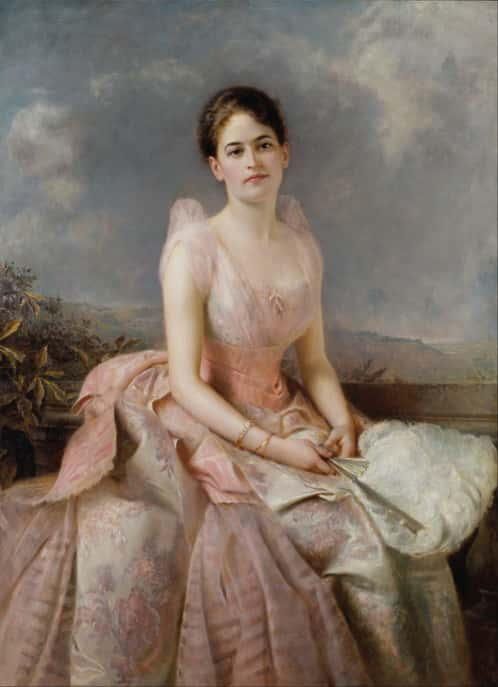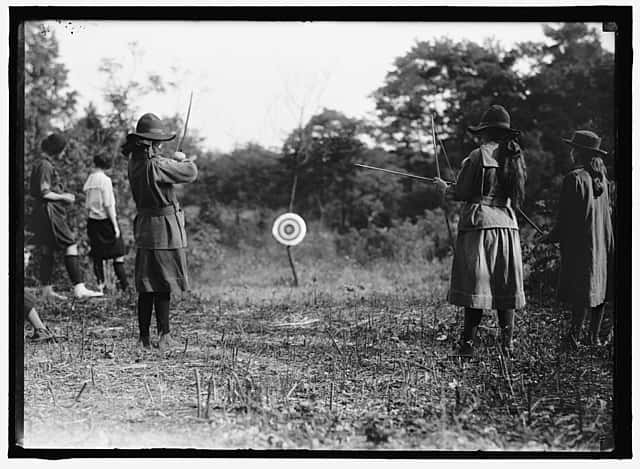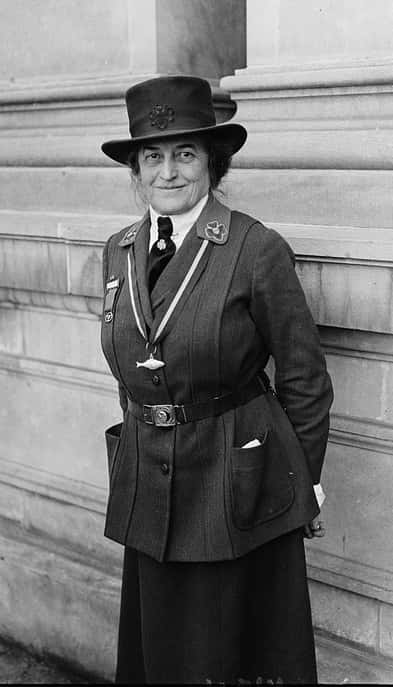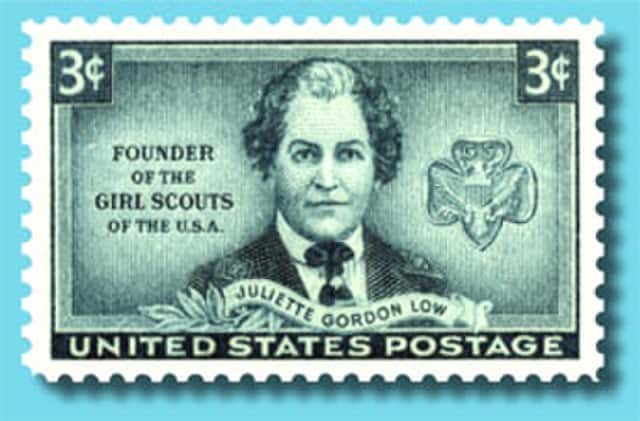(Pictured above: The Juliette Gordon Low Birthplace)
Feminism: the advocacy of women’s rights on the basis of the equality of the sexes.
The waves of feminism have been around for centuries. The first one started in 1848 at the Seneca Falls Convention when three hundred men and women rallied together for equality. But it didn’t stop there.
Now in our fourth wave of feminism, a lot has changed. There is still room to grow, but we’ve come a long way. But would you ever guess that a major player in the feminist movements throughout history could be right under your nose? Or in your pantry?
That’s right, the Girl Scouts and its founder, Juliette Gordon Low, have quietly been huge proponents of feminism since the early 1900s.

Hot Shots:
Juliette founded the Girl Scouts in 1912
She hid her breast cancer diagnosis from everyone for years
She went deaf, partially due to a grain of rice
Her house was saved after her death by the funds raised by Girl Scouts worldwide
Over 50% of women in federal-level politics are Girl Scout alumnae
Juliette’s Early Life
Juliette Magill Kinzie Gordon, nicknamed Daisy
, was born October 31, 1860, in Savannah, Georgia to William Washington Gordon II and Eleanor Nellie
Lytle Kinzie, two very accomplished people of their time.
William was a cotton broker and Confederate States Army veteran who served in the American Civil War while Nellie was fluent in six languages and part of the first family to lay ground in Chicago.
Juliette was always getting into things, whether it was getting into new activities, trouble, or harm’s way.
Her parents were never surprised to hear of a bump or bruise Juliette acquired. Her mother has been quoted saying, Daisy fell out of bed - on her head, as usual.
She broke two fingers so severely that she almost had to have them amputated in 1866. Bouts of malaria struck her as a child, as did frequent earaches, leading to partial hearing loss in one ear as a child.
When their family had to move to Chicago during the Civil War due to troops approaching dangerously close to Savannah, Juliette got brain fever.
This is an outdated term for a sickness that usually refers to an inflamed brain, similar to meningitis or encephalitis. Symptoms would include headache, flushed skin, delirium, etc.
But being illness- and accident-prone didn’t end in childhood. More on that later…
Juliette’s family was very good friends with Union General William T. Sherman, and he visited them often. On one visit, he picked up Juliette, who immediately began brushing through his hair with her hands.
He asked what she was looking for, and she replied, Your horns.
When his confusion didn’t subside, she stated bluntly, Well, aren’t you that old devil Sherman?
You can’t help but laugh at a child’s tact. But one can safely assume this behavior found her in a lot of trouble throughout her early life.
On top of her injuries and troublemaking, she was also an active child, interested in a plethora of activities, from directing plays to painting and sculpting.
One of the more prominent things she did when she was younger was to set up the Helping Hands Club with her cousins. This was a club where they learned to sew in an attempt to make clothing for Italian immigrant children.
It didn’t last long, but it was Juliette’s first step toward helping people with service.
Juliette’s Marriage
Juliette was a woman with many suitors as she aged. But none caught her eye like that of William Mackay Low.
They met around 1880 when Juliette returned to Savannah after the death of a sister. She was home helping around the house while her mother grieved. William and Juliette began courting, but it wouldn’t be in person for long.
William headed off to Oxford for three years. Juliette, not being one to sit around and wait for her man to come back and make her whole again, went off to Europe to experience life.
She didn’t sit idle either, learning some skills while she was over there: shorthand, bareback riding, and partridge hunting to name a few.
When William returned in 1885, the two were engaged. Their families were not too keen on this marriage happening.
William’s parents were quite wealthy in England and expected him to marry someone of a higher class
, while Juliette’s family seemed to not approve of marrying a man who didn’t work.
But when William’s father died, he inherited a lot of money and the wedding couldn’t be stopped.
Now, remember how Juliette was quite the unlucky lady when it came to illnesses and accidents? The year before their wedding, Juliette asked a doctor to try an experimental treatment for her earaches: injecting silver nitrate.
He refused at first, but because of how insistent she was, he caved. It didn’t work, and it resulted in the loss of almost all of her hearing in that ear.
On the day of her wedding, during the rain of the good luck rice, one grain lodged in her good ear, where it caused pain and illness.
During her honeymoon on St. Catherines Island, she underwent an operation to remove it, where her eardrum was punctured and she lost the remaining hearing she had.
Apparently, getting married on her parents’ anniversary was not as lucky as Juliette expected. And somehow, it only got worse from there.
The marriage was not a happy one. The first two years were mostly spent apart due to Juilette’s medical issues and William’s long hunting and gambling trips. Then, her inability to have children and his drinking caused a strain on the relationship.
But it wasn’t until his infidelity came to light that things really took a turn south. William had an affair with a woman named Anna Bridges Bateman.
He asked Juliette for a divorce, which she was happy to go through with, but the laws at the time stated that proof of adultery was required, which meant releasing Anna’s name.
This was difficult for Juliette because even in her most difficult moments, she wanted to protect the woman. It wasn’t Anna’s fault that William had cheated. She didn’t want to ruin Anna’s life in order to divorce William.
But after William died suddenly from a seizure in June 1905 and Juliette found out she was not awarded anything and that Anna got everything (even though the divorce wasn’t finalized yet).
William’s own sisters helped Juliette get what was rightfully hers: a nice sum of money and the home in Savannah.
Juliette decided not to risk another romance after all that, but she found other things to focus her time on.
Juliette and the Girl Scouts
The Origin
The idea of the Girl Scouts started on a simple day in 1911 when Juliette met Sir Robert Baden-Powell, the founder of the Boy Scouts. He introduced her to his sister, Agnes Baden-Powell, the head of the Girl Guides in England.
The Girl Guides became a thing when crowds of girls showed up to the first Boy Scouts meeting. Not wanting to turn them away from the experience, but also not wanting to include them in the all-boys club, Robert recruited his sister to head their group.
Juliette fell in love with the idea.
Upon arriving home to Savannah in 1912, Juliette called her cousin Nina Pape and exclaimed:
I’ve got something for the girls of Savannah, and all of America, and all the world, and we’re going to start it tonight!
And they basically did! In March of 1912, the first American Girl Guides group started with 18 girls in Savannah, promoting their core values of inclusiveness, the outdoors, self-reliance, and service.
Inclusiveness
The Girl Guides, which changed its name to the Girl Scouts in 1915, always promoted being inclusive to all girls everywhere. Things like socio-economic status, race, country of origin, religion, etc. did not affect your ability to participate in the Girl Scouts.

The Girl Scouts also took a stance against promoting any political or religious affiliation, to avoid excluding anyone due to their personal beliefs.
This was a group about empowering girls, so the only hard and fast rule the Girl Scouts stood by was to encourage the girls to think freely and develop good decision-making skills to make their own wise choices.
Shortly after its inception, the organization expanded rapidly, including many types of girls from many different cultures and backgrounds.
In the 1920s, the first all-Native American Girl Scout troops formed on the Onondaga Reservation in New York, a Mexican American Girl Scout troop formed in Houston, Texas, and the Lone Troops on Foreign Soil (later called USA Girl Scouts Overseas) registered the first Girl Scout troop in Shanghai, China.
But the Girl Scouts weren’t just happy to have a diverse group of girls in their organization. They made efforts to ensure that everyone who wanted to be a part of it could be.
In the 1930s, with all the new immigrants arriving in America, the promotional booklet Who Are the Girl Scouts?
was printed in multiple languages, including Yiddish, Italian, and Polish.
Recently, with the more widespread knowledge of transgender youth in America, the Girl Scouts has committed to being a place that can serve [trans girls] in a setting that is both emotionally and physically safe.
Even long after the death of Juliette Gordon Low, the Girl Scouts have followed her lead to include all girls of all backgrounds to prepare them for success.
The Outdoors
Getting girls outside and promoting physical activity was a hugely important thing for Juliette. She believed that providing more fun and exciting ways to become confident and competent started outdoors.
One of the very first things she implemented was starting a girls basketball league.
Also in the early days, Juliette personally took the Girl Scouts camping. As early as 1917, there were girls out in the Lowlands exploring nature and learning while they did it.
This is still available to girls every summer. At Camp Juliette Low, located on land that Juliette chose herself, Girl Scouts can learn things like sailing, archery, swimming, horseback riding, tennis, and so much more!
And don’t expect fancy log cabins at this camp. Nope! It’s all about the outdoors, as Juliette intended. Four-person platform tents are the living arrangements for the girls.
Old badges indicated knowledge of sports and other athletic activities were needed to be a well-rounded girl. The Athletics badge, for instance, required girls to be able to teach twenty popular games. The Boatswain badge requirements were to be able to row, pole, scull, or steer a boat; land a boat and make fast; and state directions by sun and stars.
Self-Reliance
Self-reliance, or independence, is crucial for a girl. This was especially true in the early days when women were not allowed to do things like open a bank account or vote. So, Juliette made it a priority for the girls to be independent.
Many of the skills taught had this purpose behind them. Things like cooking, first aid, knitting, etc. all gave the girls valuable skills to be able to thrive in the workplace and at home.
It also made it possible for more impoverished girls to stay at home and keep them out of the factories if they didn’t want to work in such conditions.
Juliette encouraged girls to take up a trade. In fact, she made sure they had a secondary trade they were skilled at as well in case the first one didn’t work out, as it often did in those days.
Putting all their eggs in one basket wasn’t beneficial if the workforce changed. She also found jobs that were in high demand at the time, such as aviation, house decorating, translating, etc.
Saving money was another piece of advice she gave. In case a job didn’t last, having money to be able to sustain oneself in between trades was important.
This sage advice is just as applicable to today’s girls! This self-reliant spirit gave girls confidence in their own power and abilities - a message that was pretty progressive for the time.
Service
Helping others is how the Girl Scouts began. This foundational belief is truly at the core of the organization. There are many accounts of the girls and the program reaching out to those in need.
During World War II, the girls operated bicycle courier services, ran Farm Aide projects, collected fat and scrap metal, grew Victory Gardens, and even sponsored Defense Institutes that taught women survival skills and techniques for comforting children during air raids.
After women earned the right to vote, the Girl Scouts stepped up to do whatever they could to help. One source reported that some girls would offer to hold women’s children while they went to the booth to vote.
In the 1950s, during the Korean War, they assembled Kits for Korea.
More recently, during the COVID-19 pandemic, they led a Mask Making Service Project where the girls and their parents could make masks for adults and kids, offering an instruction guide and places to donate them. There was even a Mask Making Patch created for this.
Juliette at the End
Based on her spirit and spunk, literally to the very end, people would have assumed (and hoped) Juliette was going to live forever. Unfortunately, in 1923, she developed breast cancer. She kept it a secret.
She got the initial malignant lumps removed, but then she caught the flu, leaving her bed-ridden till February 1925. Since she had such severe health problems all the time, this was not out of the ordinary.
That same year, she had two more secret operations and was told she had six months left to live. With this kind of news, a lot of people would relax and enjoy the final days. Not Juliette.
She reportedly sneaked away one day during recovery to give a speech at the Girl Scouts’ regional conference in Richmond. She was always serving these girls.
She might have only been the Founder at this point, and dying of cancer, but she would not be accused of taking her duties lightly. That probably would have killed her before cancer could have had a chance.
Before her 66th and final birthday, Juliette headed to Liverpool for a final option to cure her sickness. Dr. William Blair-Bell tried a developing cancer treatment that involved an IV containing a solution of colloidal lead.

As anyone with common sense in today’s day and age might have guessed, it gave Juliette lead poisoning, which she had to fight off in addition to a life-threatening disease.
On January 17, 1928, Juliette died at home in Savannah, Georgia, the birthplace of not only Juliette but also her baby: The Girl Scouts.
The next day, 250 Girl Scouts left school in order to attend her funeral at Christ Church and the burial at Laurel Grove Cemetery. An Honor Guard of Girl Scouts escorted her casket to the funeral.
Juliette was buried in her uniform. In her pocket was a note that said:
You are not only the first Girl Scout, but the best Girl Scout of them all.
This woman put everything on the line for these girls, and she never stopped even after her death. Her legacy continues over 100 years later.
After Juliette
Juliette Gordon Low has inspired so many girls and people over the years.
In 1948, there was a postage stamp printed to honor her. But at the time, the Post Office had a policy that it could not honor civic organizations. So, Congress had to pass a joint resolution just to print the stamp.

In 1953, Juliette’s Savannah house, which is now a museum, was almost demolished, but the Girl Scouts of the USA purchased it. This led to a fundraising effort across the world of girls collecting nickels, dimes, and dollars to support the restoration.
From bake sales to fashion shows to special dinners, these girls tried everything.
In 1965, Juliette’s birthplace became a National Historic Landmark.
In 1979, Juliette was inducted into the National Women’s Hall of Fame.
On May 29, 2012 (the centennial anniversary of the organization), Juliette was honored with the Presidential Medal of Freedom.
The women of the 117th United States Congress is composed of 56% Girl Scout alums, showing the staying power of Juliette’s mindset.
In 2021, five of the nine female governors and 71% of female senators were Girl Scout alums.
Today, tens of thousands of visitors go to Juliette’s house every year. It’s a place where they connect history with topics relevant to today’s girls to help ensure that the birthplace will continue to be meaningful to girls for generations to come.
Because while we may have come so far, there will always be further to go in terms of progress for girls and women.
Over 2.5 million Girl Scouts serve today, all because Juliette Gordon Low had a vision and unstoppable drive.

